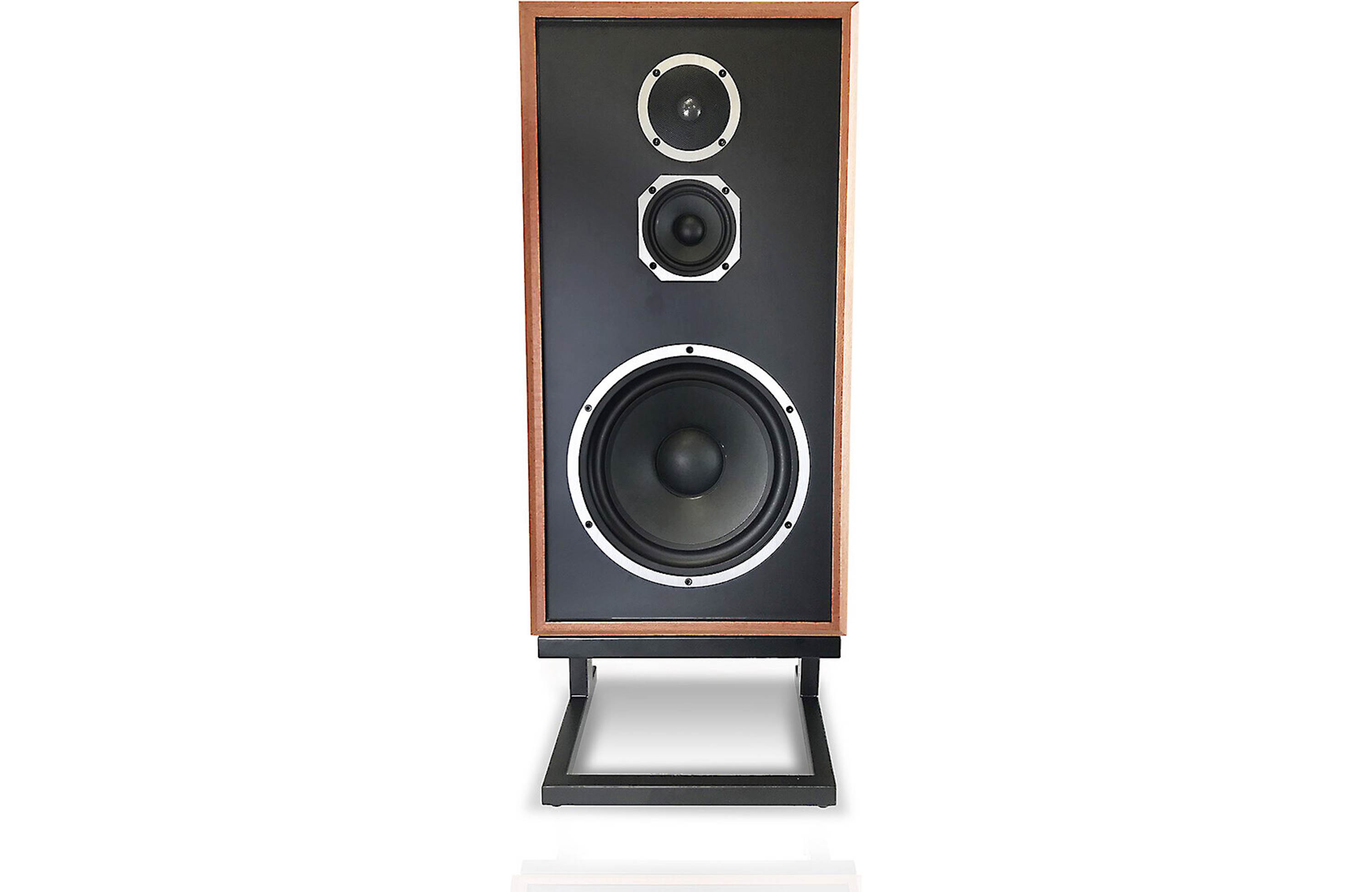Foreword / YouTube Video Review
These speakers were loaned to me by their owner for review.
The review on this website is a brief overview and summary of the objective performance of this speaker. It is not intended to be a deep dive. Moreso, this is information for those who prefer “just the facts” and prefer to have the data without the filler. The video below has more discussion.
Information and Photos
Specs from the manufacturer can be found here.
- 3-way design
- 1” aluminum dome tweeter with machined aluminum faceplate
- 4” cone midrange driver
- 10” cone woofer
- frequency response: 42-20,000 Hz (±3dB)
- recommended amplifier power: up to 200 watts
- sensitivity: 90.5 dB
- impedance: 6 ohms
- three-position acoustic balance control lets you tailor the sound for smooth frequency distribution
- acoustic suspension (sealed) cabinet built from 3/4”-thick MDF
- magnetically attached linen grille included
- optional custom linen grilles in alternate cloth colors are available
- 5-way binding posts accept pins, single or dual banana connectors, spades, or bare wire
- included powder-coated 14-gauge steel riser places speaker at a 5° upward tilt
- Dimensions and warranty:
- 13-3/4"W x 34-1/4"H x 13"D (with riser base)
- weight: 52 lbs. (with base)
- warranty: 10 years
The current price is approximately $2500 USD for a pair which includes stands. As of the time of this review’s posting there is a sale for the pair + matching stands for this same price at Crutchfield (affiliate link).
I have to say, the manual is one of the most comprehensive I’ve seen when it comes to helping the customer setup their speaker for the best overall performance.
CTA-2034 (SPINORAMA) and Accompanying Data
All data collected using Klippel’s Near-Field Scanner. The Near-Field-Scanner 3D (NFS) offers a fully automated acoustic measurement of direct sound radiated from the source under test. The radiated sound is determined in any desired distance and angle in the 3D space outside the scanning surface. Directivity, sound power, SPL response and many more key figures are obtained for any kind of loudspeaker and audio system in near field applications (e.g. studio monitors, mobile devices) as well as far field applications (e.g. professional audio systems). Utilizing a minimum of measurement points, a comprehensive data set is generated containing the loudspeaker’s high resolution, free field sound radiation in the near and far field. For a detailed explanation of how the NFS works and the science behind it, please watch the below discussion with designer Christian Bellmann:
The reference plane in this test is at the tweeter.
This speaker has (3) settings: LO/MID/HIGH which offer some ability to alter the output above 400Hz. When listening, I toggled between the MID and LO settings after quickly deciding I didn’t like the “HI” position. I also preferred the sound when the grille is on. I polled owners and found most listen to the speaker in the MID position and with the grille on so I conducted the majority of my testing with this configuration. However, I do have some additional measurements provided toward the end of this review that show the performance in the different settings.
Measurements are provided in a format in accordance with the Standard Method of Measurement for In-Home Loudspeakers (ANSI/CTA-2034-A R-2020). For more information, please see this link.
CTA-2034 / SPINORAMA:
The On-axis Frequency Response (0°) is the universal starting point and in many situations it is a fair representation of the first sound to arrive at a listener’s ears.
The Listening Window is a spatial average of the nine amplitude responses in the ±10º vertical and ±30º horizontal angular range. This encompasses those listeners who sit within a typical home theater audience, as well as those who disregard the normal rules when listening alone.
The Early Reflections curve is an estimate of all single-bounce, first-reflections, in a typical listening room.
Sound Power represents all of the sounds arriving at the listening position after any number of reflections from any direction. It is the weighted rms average of all 70 measurements, with individual measurements weighted according to the portion of the spherical surface that they represent.
Sound Power Directivity Index (SPDI): In this standard the SPDI is defined as the difference between the listening window curve and the sound power curve.
Early Reflections Directivity Index (EPDI): is defined as the difference between the listening window curve and the early reflections curve. In small rooms, early reflections figure prominently in what is measured and heard in the room so this curve may provide insights into potential sound quality.
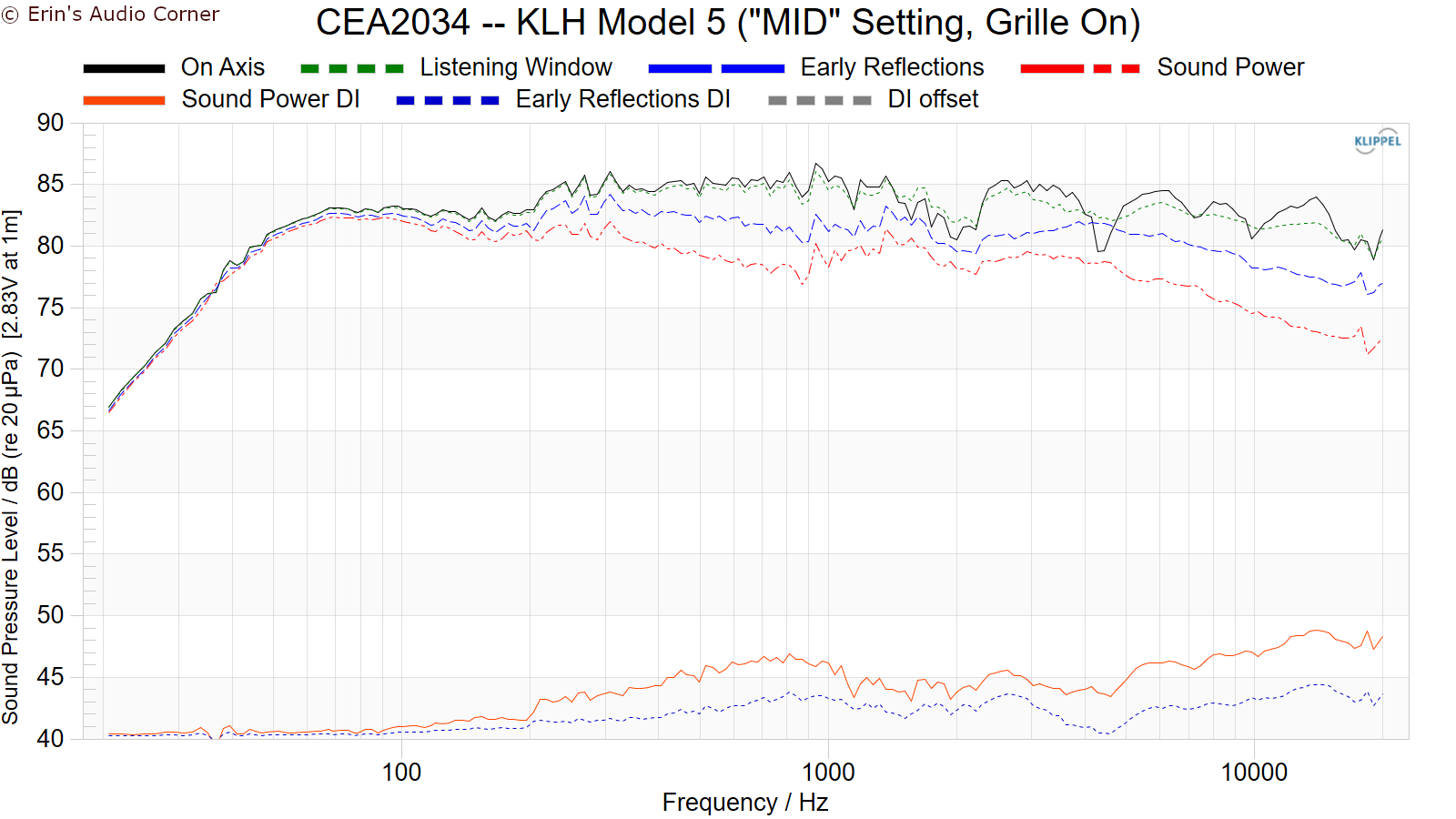
Early Reflections Breakout:
Floor bounce: average of 20º, 30º, 40º down
Ceiling bounce: average of 40º, 50º, 60º up
Front wall bounce: average of 0º, ± 10º, ± 20º, ± 30º horizontal
Side wall bounces: average of ± 40º, ± 50º, ± 60º, ± 70º, ± 80º horizontal
Rear wall bounces: average of 180º, ± 90º horizontal

Estimated In-Room Response:
In theory, with complete 360-degree anechoic data on a loudspeaker and sufficient acoustical and geometrical data on the listening room and its layout it would be possible to estimate with good precision what would be measured by an omnidirectional microphone located in the listening area of that room. By making some simplifying assumptions about the listening space, the data set described above permits a usefully accurate preview of how a given loudspeaker might perform in a typical domestic listening room. Obviously, there are no guarantees, because individual rooms can be acoustically aberrant. Sometimes rooms are excessively reflective (“live”) as happens in certain hot, humid climates, with certain styles of interior décor and in under-furnished rooms. Sometimes rooms are excessively “dead” as in other styles of décor and in some custom home theaters where acoustical treatment has been used excessively. This form of post processing is offered only as an estimate of what might happen in a domestic living space with carpet on the floor and a “normal” amount of seating, drapes and cabinetry.
For these limited circumstances it has been found that a usefully accurate Predicted In-Room (PIR) amplitude response, also known as a “room curve” is obtained by a weighted average consisting of 12 % listening window, 44 % early reflections and 44 % sound power. At very high frequencies errors can creep in because of excessive absorption, microphone directivity, and room geometry. These discrepancies are not considered to be of great importance.

Horizontal Frequency Response (0° to ±90°):

Vertical Frequency Response (0° to ±40°):

Horizontal Contour Plot (normalized):

Vertical Contour Plot (normalized):

“Globe” Plots
Horizontal Polar (Globe) Plot:
This represents the sound field at 2 meters - above 200Hz - per the legend in the upper left.
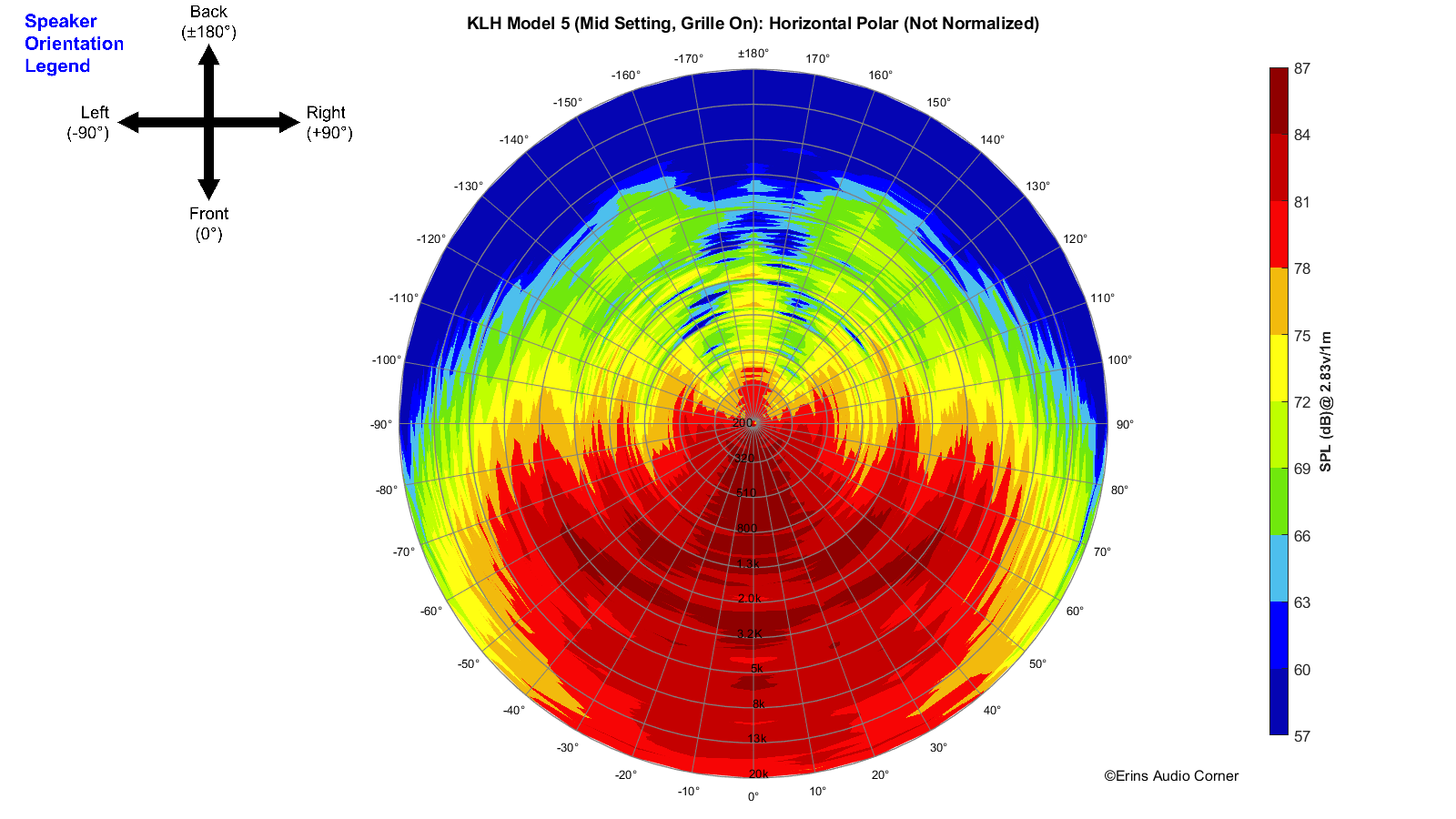
Vertical Polar (Globe) Plot:
This represents the sound field at 2 meters - above 200Hz - per the legend in the upper left.

Additional Measurements
Response Linearity
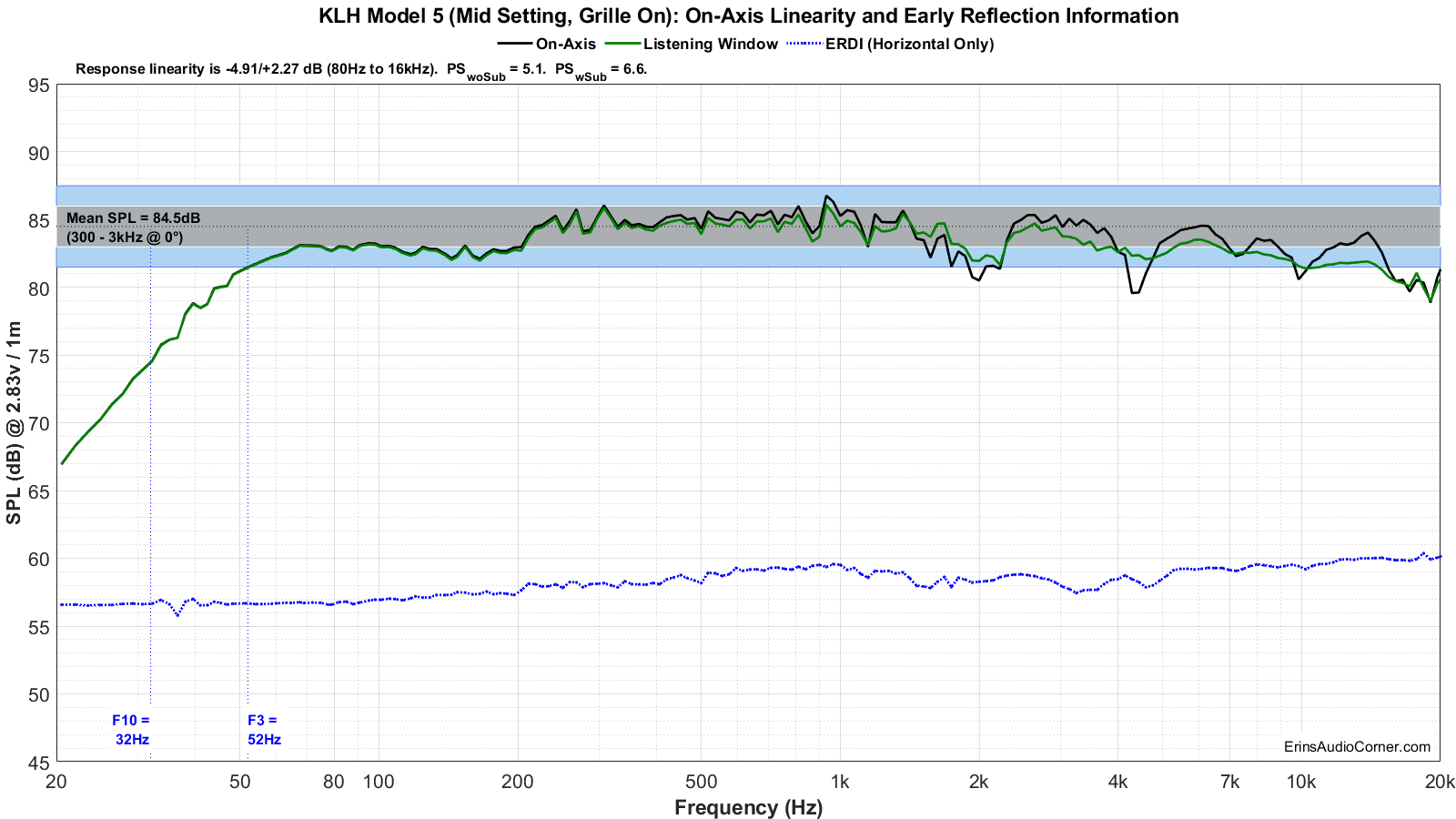
Impedance Magnitude and Phase
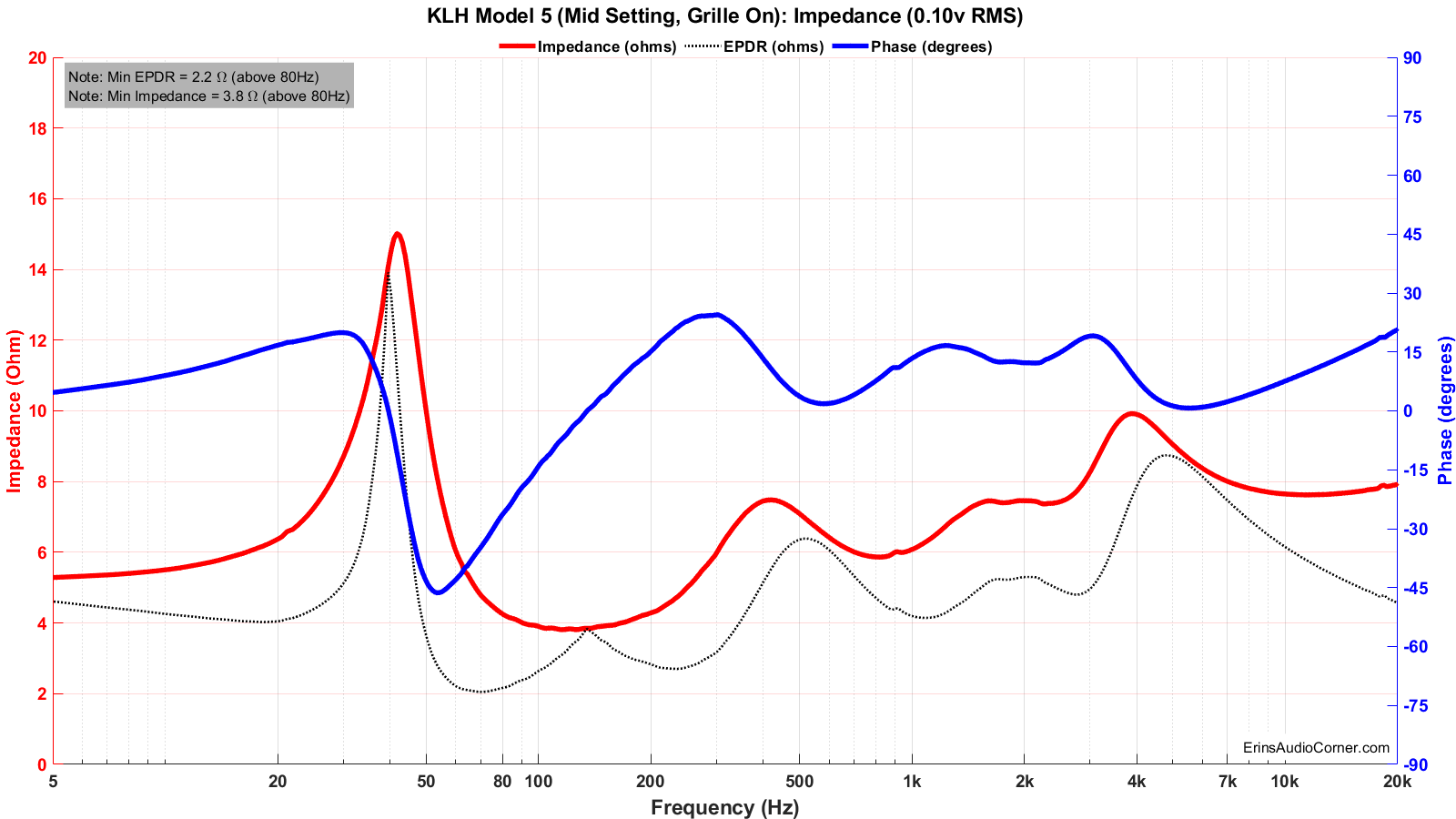
Step Response
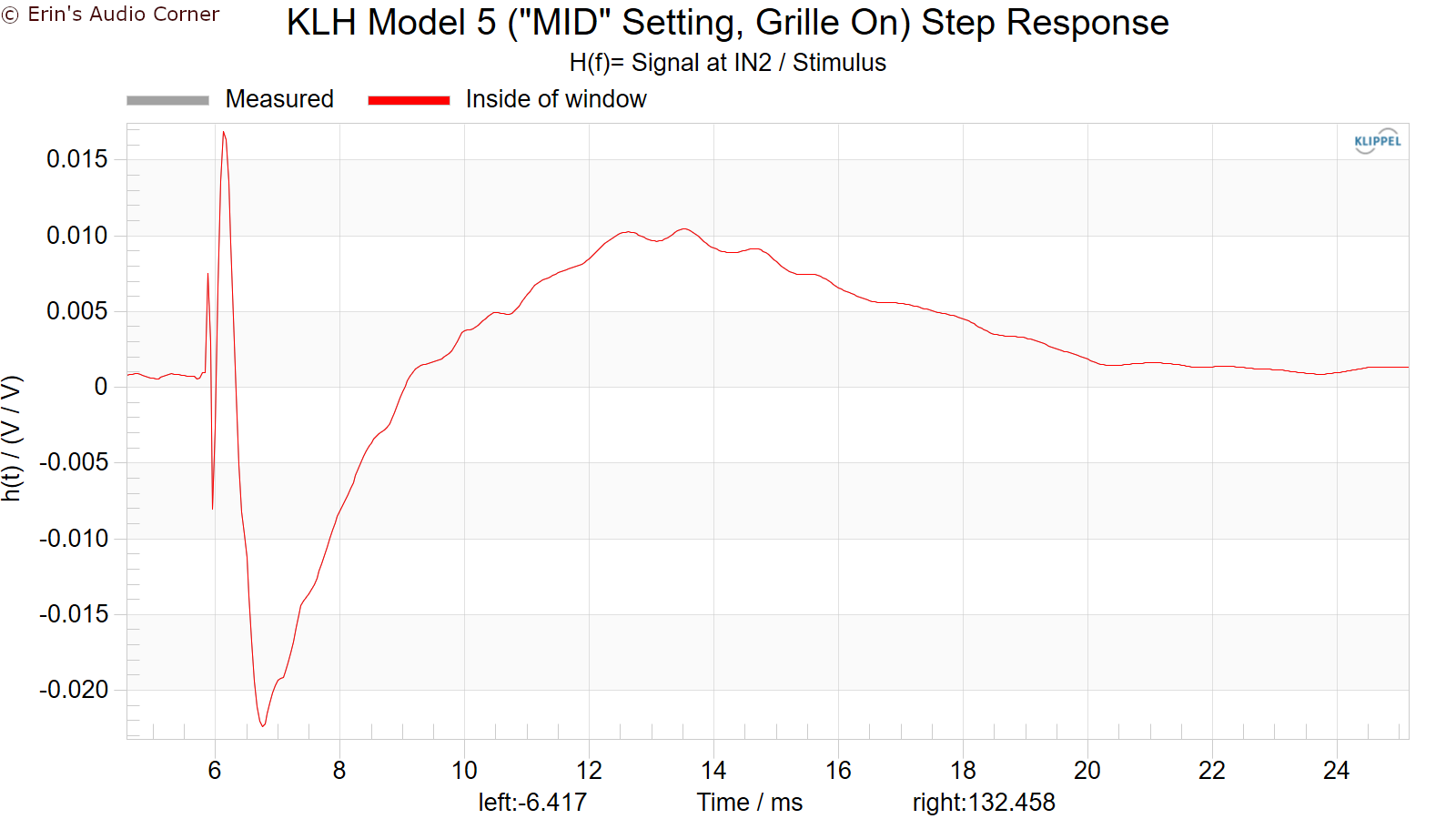
Group Delay

Harmonic Distortion
Harmonic Distortion at 86dB @ 1m:

Harmonic Distortion at 96dB @ 1m:
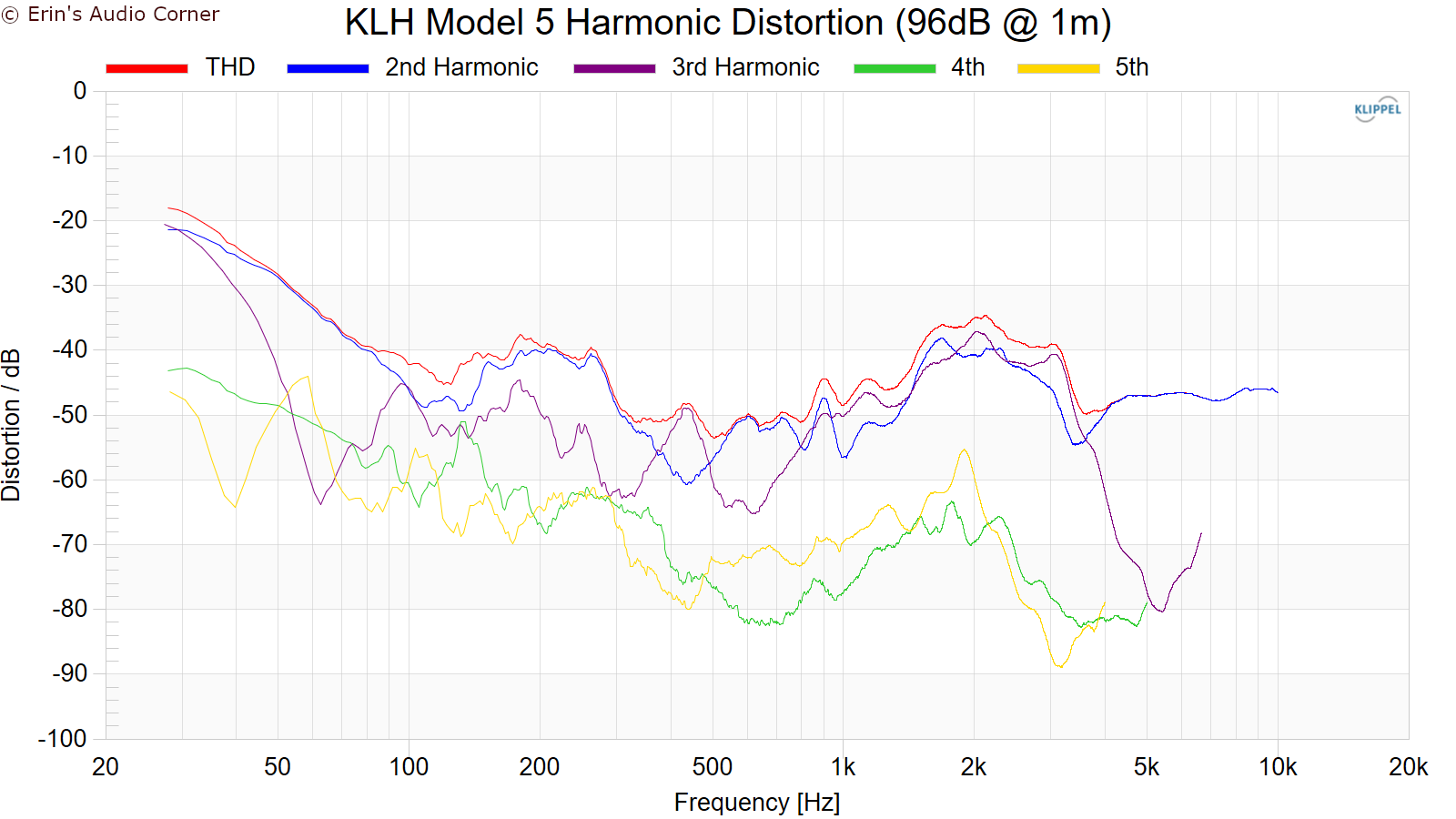
Dynamic Range (Instantaneous Compression Test)
The below graphic indicates just how much SPL is lost (compression) or gained (enhancement; usually due to distortion) when the speaker is played at higher output volumes instantly via a 2.7 second logarithmic sine sweep referenced to 76dB at 1 meter. The signals are played consecutively without any additional stimulus applied. Then normalized against the 76dB result.
The tests are conducted in this fashion:
- 76dB at 1 meter (baseline; black)
- 86dB at 1 meter (red)
- 96dB at 1 meter (blue)
- 102dB at 1 meter (purple)
The purpose of this test is to illustrate how much (if at all) the output changes as a speaker’s components temperature increases (i.e., voice coils, crossover components) instantaneously.
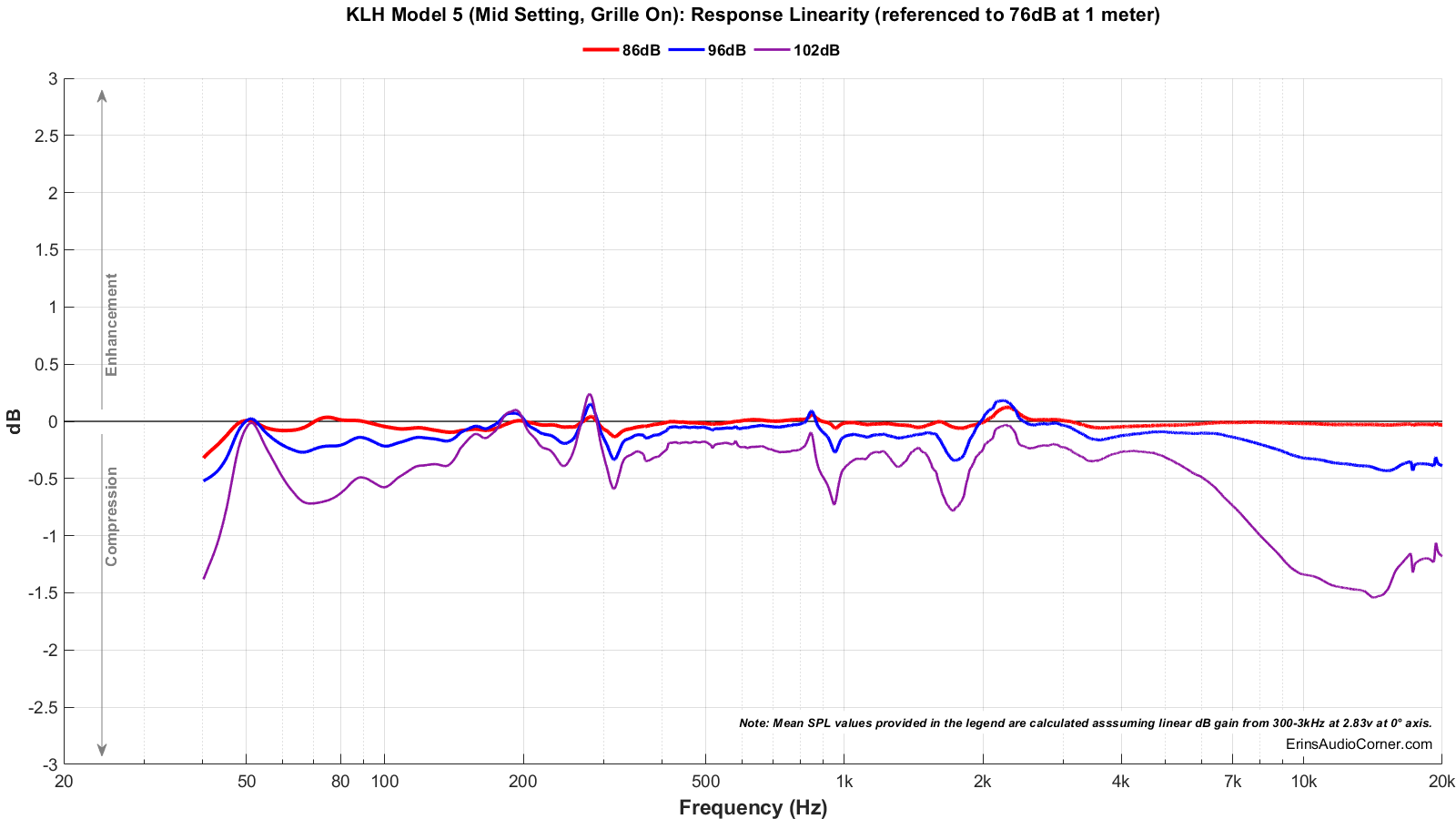
Multitone Distortion
The following tests are conducted at (4) approximate equivalent output volumes: 70/79/87/96dB @ 1 meter. The (4) voltages listed in the legend result in these SPL values.
The test was conducted in (3) manners:
- Full bandwidth (20Hz to 20kHz)
- 80Hz to 20kHz
The reason for the two measurements is to simulate running the speaker full range vs using a high-pass filter at 80Hz. However, note: the 2nd test low frequency limit at 80Hz is a “brick wall” and doesn’t quite emulate a standard filter of 12 or 24dB/octave. But… it’s close enough.
For information on how to read the below data, watch this video:
- Full bandwidth (20Hz to 20kHz)
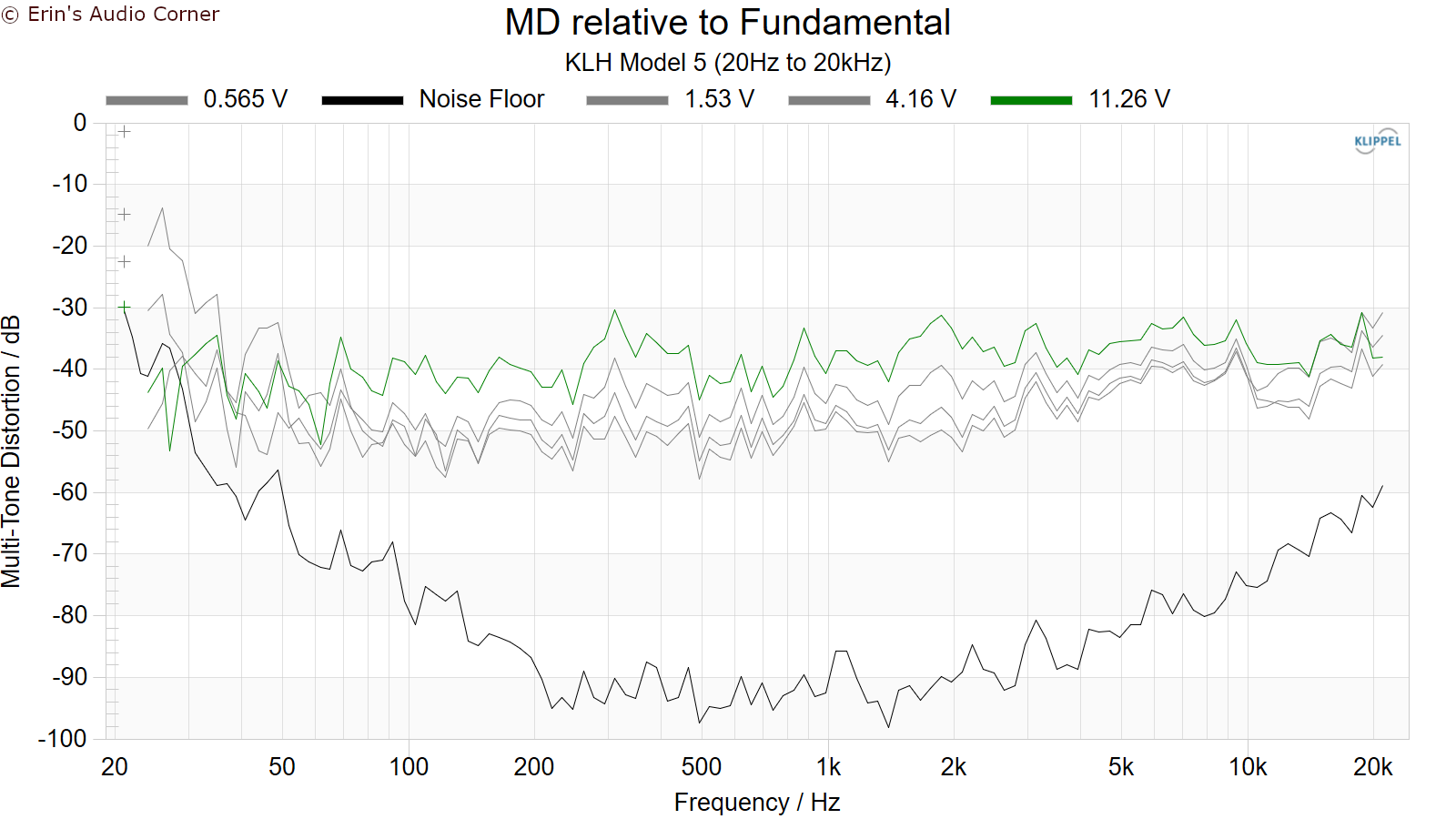
- 80Hz to 20kHz
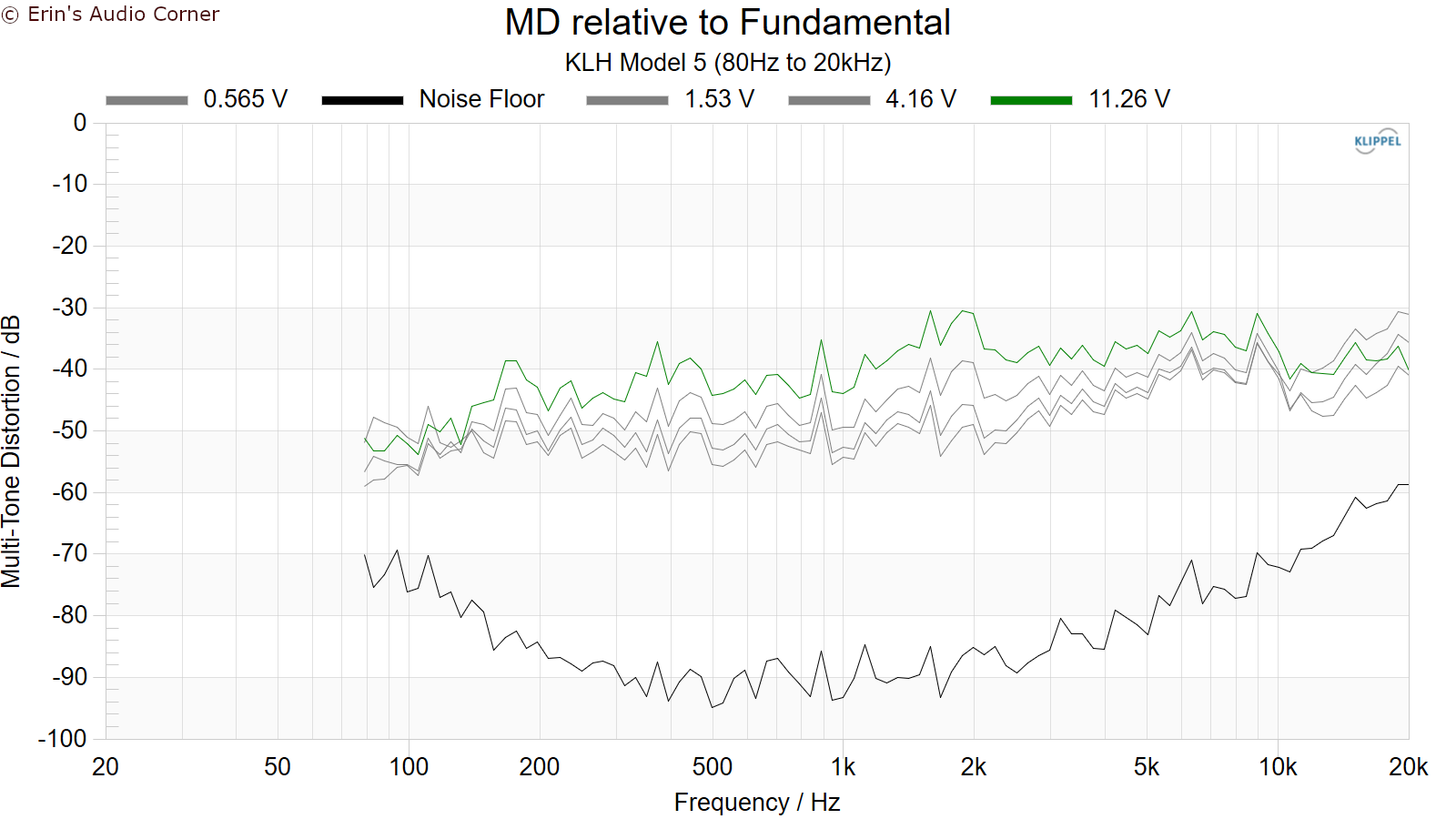
Additional Settings’ Data
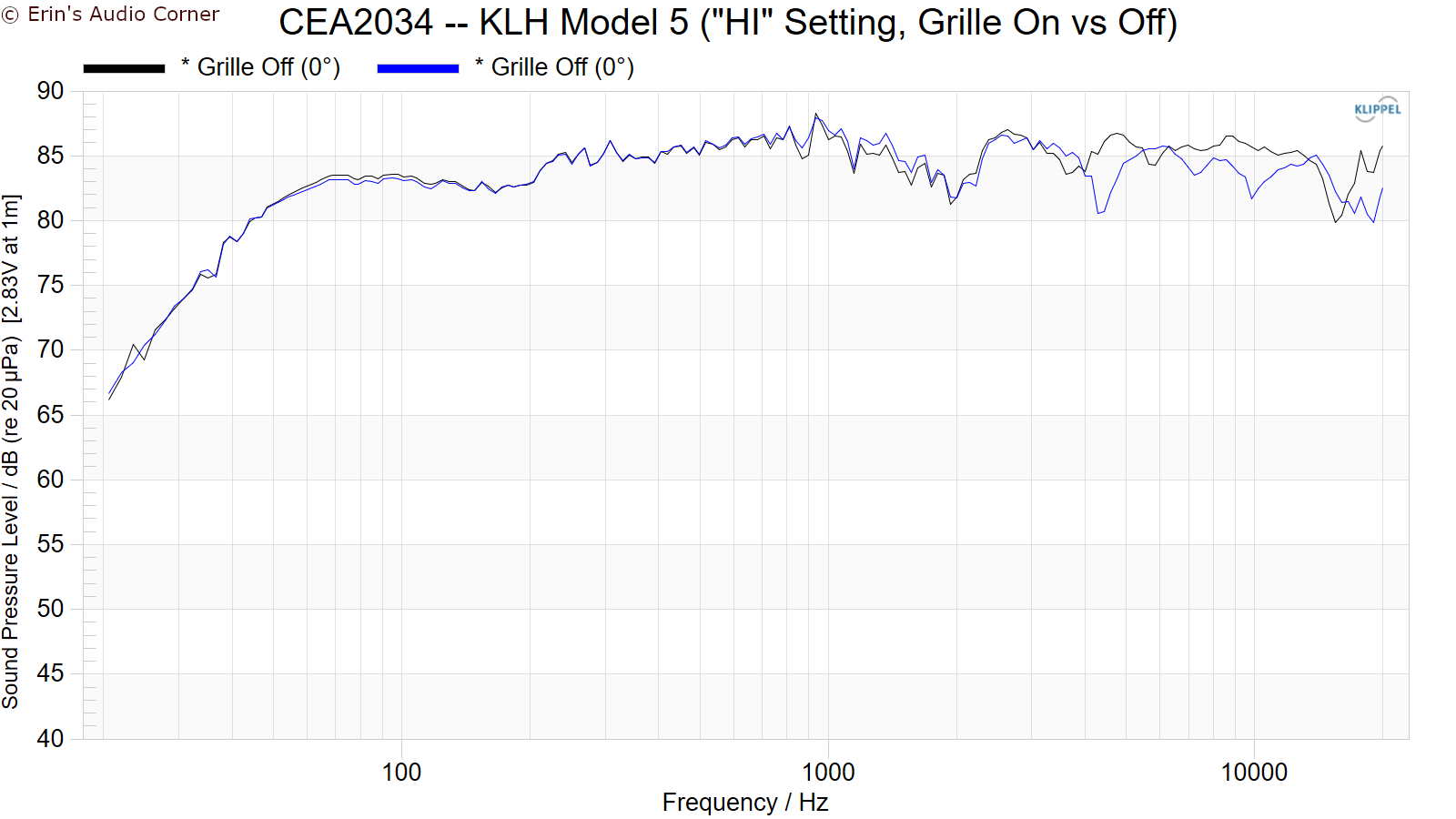
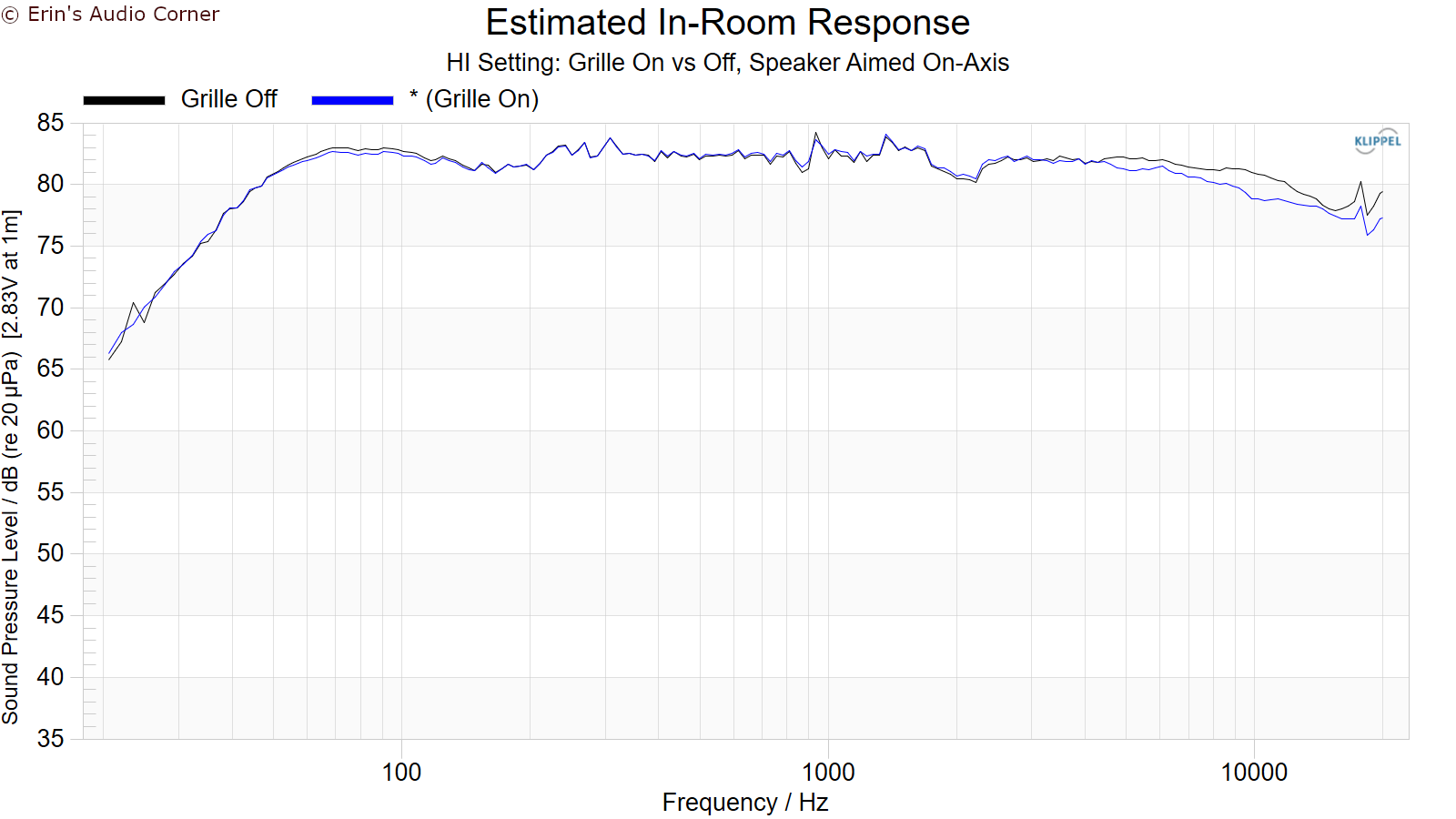
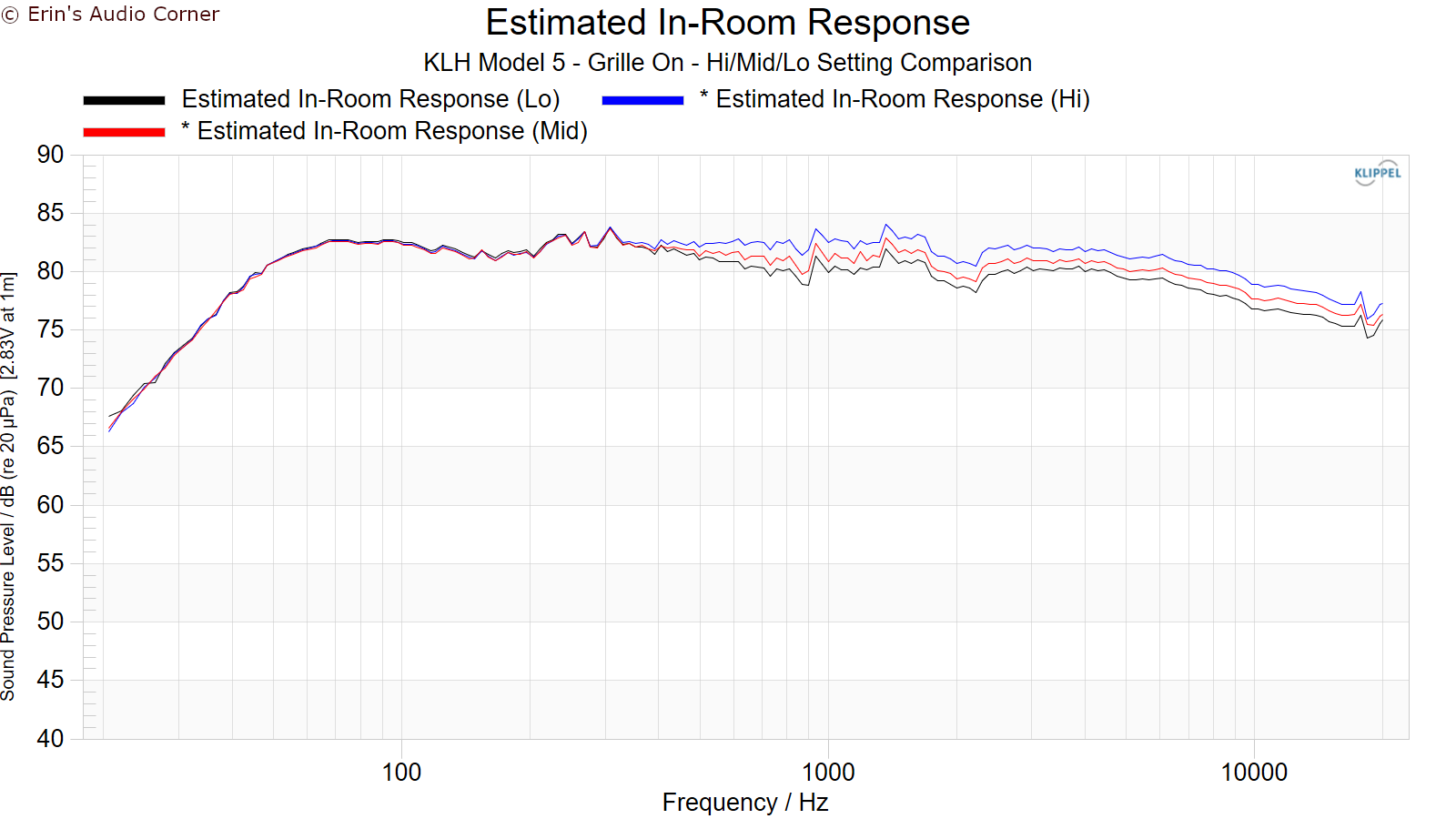
Parting / Random Thoughts
As stated in the Foreword, this written review is purposely a cliff’s notes version. For details about the performance (objectively and subjectively) please watch the YouTube video. But a couple quick notes based on my listening and what I see in the data:
- Hi with grille. Something missing in the midrange. Data shows a dip in the lower midrange/midbass transition.
- “Hi” setting is too midrange (upper and lower) heavy. I prefer the mid and low setting. But the beauty is you can set it up either way.
- While the manual discusses the applicability of the HI/MID/LO settings being for different room types (“live”, “dead”), keep in mind that you can also use these settings as somewhat of a reverse boundary compensation setting. For example, if you need to place the speakers near a wall, odds are you’ll find the “HI” setting works better than “LO”.
- I still feel like even in Lo that the midrange around 800Hz is a bit much. In evaluating the data I see there is some minor resonance that shows up in the impedance at about 900Hz and I wonder if that is what I was hearing.
- As for grill on versus off, I found grill on helps attenuate the highs and provides a more balanced sound in any configuration.
- At higher volume there is a standout between 2-4 kHz. The frequency response doesn’t show anything that is concrete for this. At best, there does seem to be a mild flattening of the response in this region before falling off above this region. However, I also see the harmonic distortion data indicates a rise around 2kHz. Truthfully, I’d be surprised if that was what I was hearing. But there is no way for me to say that it wasn’t. Or maybe I just didn’t hear what I think I heard… can’t rule that out. Subjective evaluations are tricky things.
- The bass isn’t as punchy as I’d prefer. This might be perfect for some (depending on room size or tastes) but I’d like a bit more (3dB) to get more kick drum bump at 50Hz. Either that, or use EQ to bring up 100-120Hz. When looking at the data I do see that there is some baffle step loss below 200Hz and my assumption is what I heard was the lack of midbass relative to midrange.
- It is worth noting though that my room is reasonably “dead” and I still prefer LO mode.
- On-axis doesn’t work well for me. I prefer slightly angled out. 10-20 degrees seemed to sound best to me.
- Width is really good and there seems to be good depth of soundstage on these. Interesting thing is that with panned sounds they sound deeper at the edges. I’d be pressed to say why this is but I do see that the data shows the horizontal radiation is wider between 1.5kHz to 5kHz. Maybe the panned sounds are in this region?
- Imaging is not precise as you would get with a narrower radiation pattern, but I can live with that.
I initially did not like these speakers. The manual indicated that the HI setting would work best for me since I have a pretty “dead” room. In application, though, the HI setting was too midrange heavy. After playing around with the different settings and aiming I found that the LO setting was best for my situation. I believe the reason for this is because my speakers are placed pretty far away from the walls (3 feet from the sidewalls and the front wall). Looking at the response data, the baffle step creates an imbalance between midbass and midrange (around 200-400Hz) in all (3) settings but the HI setting is the worst offender. When LO/MID are used the baffle step is made less noticeable so that when pulled further out in the room - and thus having less bass reinforcement from the walls - the bass is more in line with the midrange. The LO/MID/HI adjustability might make this the safest option for a passive speaker in this style to go with, even though I personally still prefer the Wharfedale Linton myself.
Support / Contribute
If you find this review helpful and want to help support the cause that would be AWESOME! There are a few ways you can do so below. Your support helps me pay for new items to test, hardware, miscellaneous items needed for testing, new speakers to review and costs of the site’s server space and bandwidth. Any help is very much appreciated.
Join my Patreon: Become a Patron!
If you find yourself interested in buying this speaker, please consider using one of my affiliate links below. It costs you no additional money but does help me earn a small commission which helps me pay for gear to test and other review gear.
You can also join my Facebook and YouTube pages if you’d like to follow along with updates.
